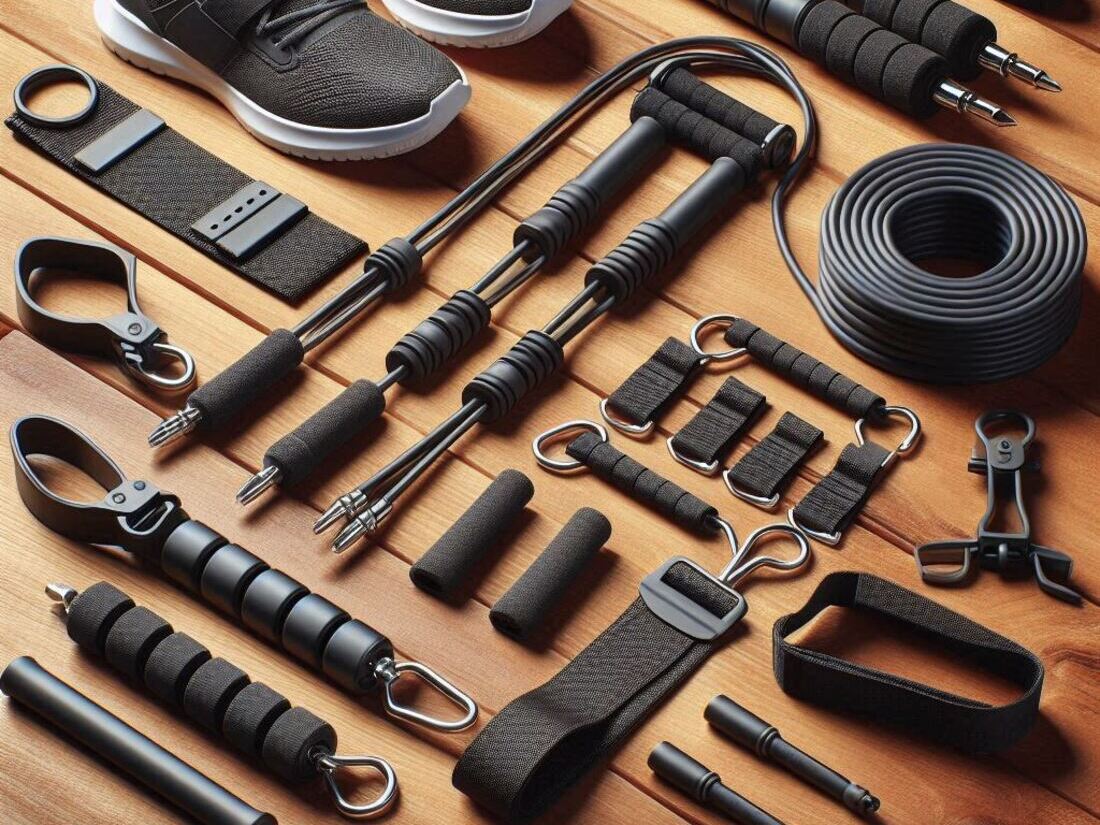Tired of crowded gyms and expensive equipment?
Discover the hidden potential of resistance bands.
Often overlooked, these versatile tools pack a powerful punch when it comes to building strength and improving overall fitness.

Traditional weightlifting can be intimidating and costly, requiring dedicated gym space and a variety of equipment.
Resistance bands offer a refreshing alternative, providing a convenient, affordable, and effective way to achieve your fitness goals.
Let’s explore the world of resistance bands and uncover their transformative power.
Understanding Resistance Bands
Resistance bands offer a versatile and accessible approach to strength training.
Let’s explore the different types and their benefits:
Types of Resistance Bands

- Flat resistance bands: Long, flat bands typically used for lower body exercises and dynamic stretches.
- Looped resistance bands: Circular bands that offer continuous resistance for various exercises.
- Tube resistance bands: Tubular bands with handles for upper body and core workouts.
Benefits of Using Resistance Bands for Strength Training
- Portability: Easily take your workout anywhere.
- Affordability: Cost-effective compared to traditional gym equipment.
- Versatility: Target multiple muscle groups with various exercises.
- Low impact: Suitable for individuals with joint pain or injuries.
- Progressive overload: Increase resistance by choosing thicker bands or performing more repetitions.
How Resistance Bands Compare to Traditional Weights
While resistance bands offer numerous advantages, it’s essential to understand their differences from traditional weights:
- Resistance curve: Resistance bands provide variable resistance, increasing tension as you stretch the band.
- Range of motion: Some exercises may have a limited range of motion compared to free weights.
- Weight increments: Resistance bands offer continuous resistance rather than fixed weight increments.
By understanding these factors, you can determine if resistance bands are the right choice for your fitness goals.
Building Strength with Resistance Bands
Resistance bands offer a surprising amount of challenge and versatility for building strength. Let’s explore effective workout routines:
Full-Body Resistance Band Workouts
A well-rounded routine incorporates exercises for major muscle groups:
- Warm-up: Light cardio, dynamic stretches.
- Workout: Squats, lunges, push-ups, rows, bicep curls, tricep extensions, overhead press.
- Cool-down: Static stretches.
Targeting Specific Muscle Groups
Isolate specific muscle groups for focused development:
- Chest: Chest press, flyes, push-ups.
- Back: Rows, pull-aparts, lat pulldowns (using a door anchor).
- Arms: Bicep curls, tricep extensions, hammer curls.
- Legs: Squats, lunges, glute bridges, calf raises.
- Core: Planks, Russian twists, leg raises.
Incorporating Resistance Bands into Cardio Workouts
Enhance your cardio workouts with resistance band exercises:
- Running or jogging: Add arm movements for upper body engagement.
- Swimming: Simulate water resistance for added challenge.
- Cycling: Use resistance bands for upper body exercises during breaks.
By incorporating these workout ideas, you can effectively build strength and endurance using resistance bands.
Resistance Band Workouts for Different Fitness Levels
Resistance bands cater to various fitness levels, offering progressive challenges:
Beginner-Friendly Resistance Band Exercises
Start with basic exercises to build strength and coordination:
- Bodyweight squats with band resistance
- Standing bicep curls
- Lateral shoulder raises
- Glute bridges with band resistance
- Plank with band rows
Intermediate and Advanced Resistance Band Routines
Increase intensity and resistance for continued progress:
- Banded push-ups
- Bent-over rows
- Fire hydrants with band resistance
- Cossack squats with band
- Chest press against a wall
Creating Progressive Overload with Resistance Bands
To continually challenge your muscles, employ these strategies:
- Increase repetitions: Perform more repetitions of each exercise.
- Add resistance: Choose thicker bands or multiple bands for added challenge.
- Vary exercises: Introduce new movements to target different muscle groups.
- Increase speed: Perform exercises at a faster pace to increase intensity.
By gradually increasing the difficulty, you can prevent plateaus and continue to build strength.
Tips for Effective Resistance Band Training
To maximize the benefits of resistance band training, focus on these key elements:
Proper Form and Technique
- Master basic movements: Learn correct form for exercises like squats, lunges, and rows before adding resistance bands.
- Focus on controlled movements: Avoid jerky motions to prevent injuries and maximize muscle engagement.
- Engage core muscles: Maintain core stability throughout your workouts.
Choosing the Right Resistance Level
- Start with lighter resistance: Gradually increase the resistance as you get stronger.
- Experiment with different band thicknesses: Find the right level of challenge for each exercise.
- Consider your fitness goals: Choose resistance bands that align with your desired outcomes.
Incorporating Resistance Bands into a Balanced Fitness Routine
- Combine with cardio: Incorporate resistance band exercises into your warm-up or cool-down.
- Create full-body workouts: Include exercises targeting all major muscle groups.
- Listen to your body: Take rest days and allow muscles to recover.
By following these tips, you can optimize your resistance band workouts and achieve your fitness goals.
Resistance Band Accessories and Variations

To enhance your resistance band workouts, consider these accessories and creative variations:
Resistance Band Accessories
- Door anchors: Secure bands to doors for various exercises.
- Handle attachments: Improve grip and comfort for upper body exercises.
- Ankle cuffs: Expand exercise options for lower body workouts.
Creative Ways to Use Resistance Bands
- Plyometrics: Incorporate jumps and explosive movements for added intensity.
- Suspension training: Use bands for bodyweight exercises with added resistance.
- Partner workouts: Engage in fun and challenging workouts with a partner.
By utilizing accessories and experimenting with different techniques, you can keep your resistance band workouts engaging and effective.
Benefits of Resistance Band Training
Resistance bands offer a wide range of benefits for individuals of all fitness levels:
- Muscle building and toning: By progressively overloading the muscles, resistance bands can effectively build strength and create lean muscle mass.
- Improved flexibility and mobility: The elastic nature of resistance bands promotes increased range of motion and flexibility.
- Injury prevention and rehabilitation: Low-impact nature makes them suitable for individuals recovering from injuries or with joint pain.
- Portability and convenience: Easily packable for workouts on the go, allowing you to exercise anytime, anywhere.
By incorporating resistance band training into your fitness routine, you can experience a multitude of benefits for your overall health and well-being.
Resistance Band Workout Routines

Tailor your resistance band workouts to your specific fitness goals:
Sample Workouts for Different Fitness Goals
- Strength: Focus on compound exercises like squats, lunges, and rows with added resistance.
- Endurance: Perform circuit training with high repetitions and minimal rest.
- Flexibility: Incorporate dynamic stretches and mobility exercises using resistance bands.
Combining Resistance Bands with Bodyweight Exercises
Enhance your workouts by combining resistance bands with bodyweight movements:
- Push-up variations: Add band resistance for increased challenge.
- Squat variations: Use bands for added glute activation.
- Plank variations: Incorporate band pulls for core engagement.
By combining these elements, you can create well-rounded and effective resistance band workouts.
Resistance Band Storage and Maintenance

Proper care ensures the longevity of your resistance bands:
Resistance Band Storage
- Compact storage: Roll up bands and store them in a cool, dry place.
- Avoid direct sunlight: Prolonged exposure can degrade the band material.
- Utilize storage bags: Protect bands from dust and damage.
Maintaining Resistance Band Condition
- Regular inspection: Check for tears or fraying.
- Cleaning: Wipe down bands with a damp cloth to remove sweat and dirt.
- Avoid extreme temperatures: Store bands away from heat sources.
By following these tips, you can extend the lifespan of your resistance bands and maintain their effectiveness.
FAQs About Resistance Bands
To address common questions about resistance band training, here are some frequently asked questions:
- What resistance level should I start with? Begin with light resistance and gradually increase as you gain strength.
- Can I build muscle with resistance bands? Absolutely, resistance bands can effectively build strength and muscle mass.
- How often should I use resistance bands? Aim for 2-3 workouts per week, incorporating a variety of exercises.
- Are resistance bands suitable for all fitness levels? Yes, resistance bands can be adapted to suit beginners, intermediate, and advanced exercisers.
- Can I use resistance bands for cardio workouts? While primarily for strength training, resistance bands can be incorporated into dynamic warm-ups or added to cardio exercises for increased intensity.
Testimonials
“I was surprised at how effective resistance band workouts can be. I’ve seen noticeable improvements in my strength and flexibility.” – Sarah, 32
“Resistance bands are perfect for traveling. I can fit them in my suitcase and still get a great workout.” – David, 25
“I’ve been using resistance bands for physical therapy and they’ve helped me recover from my injury while building strength.” – Emily, 45
These testimonials highlight the versatility and benefits of resistance band training.
Comparing Resistance Bands to Other Home Workout Equipment
While resistance bands offer numerous advantages, it’s essential to understand their limitations compared to other home workout equipment:
- Resistance bands vs. dumbbells:Dumbbells provide fixed resistance, while resistance bands offer variable resistance. Dumbbells might be better suited for heavy lifting and power-based exercises.
- Resistance bands vs. kettlebells: Kettlebells offer dynamic movements and full-body workouts, while resistance bands excel in isolation exercises and rehabilitation.
- Resistance bands vs. bodyweight exercises: Resistance bands add resistance to bodyweight exercises, enhancing the challenge. However, bodyweight exercises alone might not be sufficient for advanced lifters.
Consider combining resistance bands with other equipment to create a well-rounded home workout routine.
For example, use resistance bands for warm-ups, accessory exercises, or to target specific muscle groups.
By understanding these comparisons, you can make informed decisions about incorporating resistance bands into your fitness regimen.
Conclusion
Resistance bands offer a versatile, affordable, and effective way to enhance your fitness routine.
By incorporating them into your workouts, you can build strength, improve flexibility, and achieve your fitness goals.
Embrace the power of resistance bands and unlock your full potential.
Don’t let limited space or gym memberships hold you back.
Create your own fitness journey with this versatile equipment.
Ready to experience the resistance band revolution?
Explore our range of high-quality resistance bands to find the perfect fit for your needs.
Visit our website Reliable Home Fitness Website to start your fitness journey today!
References
Effects of training with elastic resistance versus conventional resistance on muscular strength: A systematic review and meta-analysis, National Institutes of Health (NIH) (.gov)
Related Posts



